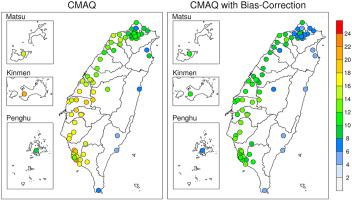当前位置:
X-MOL 学术
›
Atmos. Environ.
›
论文详情
Our official English website, www.x-mol.net, welcomes your
feedback! (Note: you will need to create a separate account there.)
Evaluation of real-time PM2.5 forecasts with the WRF-CMAQ modeling system and weather-pattern-dependent bias-adjusted PM2.5 forecasts in Taiwan
Atmospheric Environment ( IF 4.2 ) Pub Date : 2021-01-01 , DOI: 10.1016/j.atmosenv.2020.117909 Fang-Yi Cheng , Chih-Yung Feng , Zhih-Min Yang , Chia-Hua Hsu , Ka-Wa Chan , Chia-Ying Lee , Shuenn-Chin Chang
Atmospheric Environment ( IF 4.2 ) Pub Date : 2021-01-01 , DOI: 10.1016/j.atmosenv.2020.117909 Fang-Yi Cheng , Chih-Yung Feng , Zhih-Min Yang , Chia-Hua Hsu , Ka-Wa Chan , Chia-Ying Lee , Shuenn-Chin Chang

|
Abstract A real-time air quality forecasting (AQF) system was developed in Taiwan using the Weather Research and Forecasting meteorological model and Community Multiscale Air Quality model framework. This study evaluated the performance of the one-year archived AQF PM2.5 forecasts (October 2018 to September 2019) and developed a bias-correction method to improve the accuracy of the PM2.5 forecasts. The bias-correction method incorporates a cluster-analysis-based synoptic weather pattern (WP) classification (one type of analog method). In principle, the historical model errors are categorized according to the synoptic WP and used to adjust the PM2.5 forecast. First, the synoptic WPs are determined using K-means cluster analysis (six WPs were identified). Second, the historical AQF PM2.5 bias at each surface station is estimated for each classified WP. Third, a linear-regression relationship between the AQF PM2.5 bias and PM2.5 forecasts for the six WPs is developed to postprocess the PM2.5 forecasts. The AQF PM2.5 bias is found to have a strong dependency on the synoptic WP. A performance assessment of the AQF PM2.5 forecasts reveals systematic PM2.5 underprediction, with the most pronounced underprediction occurring on days associated with weak synoptic weather conditions. Under these conditions, a severe PM2.5 event is likely to occur in Taiwan. The bias-correction method is able to reduce the PM2.5 forecast error and improve the root mean square error (RMSE) and mean bias (MB) calculations. The improvement is most significant on days associated with a weak synoptic WP and in regions where high PM2.5 concentrations are likely to occur. The method is shown to be effective at reducing the AQF PM2.5 bias.
更新日期:2021-01-01











































 京公网安备 11010802027423号
京公网安备 11010802027423号